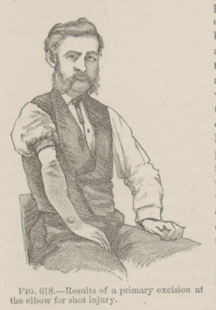Title: Gove, C. H.
Source text: The Medical and Surgical History of the War of the Rebellion. (1861-65.), Part 2, Volume 2 (Washington, DC: Government Printing Office, 1876), 868.
Civil War Washington ID: med.d2e31347
TEI/XML: med.d2e31347.xml
CASE 1795.—Private C. H. Gove, Co. I, 145th New York, aged 18 years, was wounded at Chancellorsville, May 3, 1863, by a minié ball, which entered the anterior aspect of the forearm above the middle, and made its exit through the olecranon process. On May 8th, resection of the olecranon process (and probably of the articular extremities of the humerus, radius, and ulna, as the interspace between the ends of the bones was very considerable) was performed on the field by a Confederate surgeon; and an angular splint was applied, with cold-water dressings. Gove was a prisoner for thirteen days after he was wounded; but in June was sent to Washington, was treated at Mount Pleasant Hospital, and thence transferred to Satterlee Hospital, Philadelphia, where he was received June 21st. Acting Assistant Surgeon T. G. Morton reported that "the wound was then sloughing; the use of the splint and cerate dressing was continued for about three weeks, when the splint was removed. The wound nearly healed, leaving the joint with its movement impaired and the arm semi-flexed," and the patient was discharged the service November 21, 1863, and pensioned. Mr. Gove visited the Army Medical Museum February 3, 1873, and a photograph, represented by the cut (FIG. 618), was then taken. A memorandum made at the time states that there was good use of the hand and very fair use of the forearm. Examiner H. L. Dodge, of Boston, reported, November 24, 1863: "There is great separation between the bonus of the arm and the forearm." Examiner G. S. Jones reported, October 6, 1866: "The forearm is powerless and useless." The last examination of the pensioner was made under Surgeon Thomas Franklin Smith, of New York, September 17, 1873, who reported: "Complete resection of the right elbow joint. The hand hangs to the side, and for purposes of manual labor the disability is equal to the loss of the arm." Pensioner was paid March 4, 1874.
